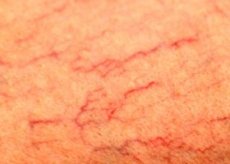Medical expert of the article
New publications
Ataxia telangiectasia.
Last reviewed: 05.07.2025

All iLive content is medically reviewed or fact checked to ensure as much factual accuracy as possible.
We have strict sourcing guidelines and only link to reputable media sites, academic research institutions and, whenever possible, medically peer reviewed studies. Note that the numbers in parentheses ([1], [2], etc.) are clickable links to these studies.
If you feel that any of our content is inaccurate, out-of-date, or otherwise questionable, please select it and press Ctrl + Enter.

Causes of ataxia-telangiectasia
Inherited in an autosomal recessive manner. Ataxia-telangiectasia is a consequence of a mutation in the gene encoding the ataxia-telangiectasia-mutant (ATM) protein. ATM plays a role in the transduction of mitogenic signals, meiotic recombination, and cell cycle control.
Symptoms of ataxia-telangiectasia
The onset of neurological symptoms and immunodeficiency may vary. Ataxia appears when the child begins to walk. Progression of neurological symptoms leads to severe impairment of motor activity. Speech becomes unclear, choreoathetoid movements and nystagmus are noted, muscle weakness progresses to muscular atrophy. Telangiectasias may not appear until 4-6 years of age; they are most noticeable on the bulbar conjunctiva, on the ears, on the skin of the cubital and popliteal fossa, and on the lateral surfaces of the neck. Recurrent infections of the paranasal sinuses and lungs lead to recurrent pneumonia, bronchiectasis, and chronic restrictive lung disease. Patients have a deficiency of IgA and IgE and progressive T-lymphocyte disorders. Endocrine abnormalities such as gonadal dysgenesis, testicular atrophy, and diabetes mellitus occur.
Diagnosis and treatment of ataxia-telangiectasia
There is a high incidence of malignant neoplasms (leukemia, brain tumors, stomach cancer), chromosome breaks with DNA repair defects. Serum alpha-fetoprotein levels are usually elevated.
Therapy includes antibiotics, IVIT, but there is no effective treatment for CNS abnormalities. Thus, neurological symptoms progress, leading to death at about 30 years of age.


 [
[